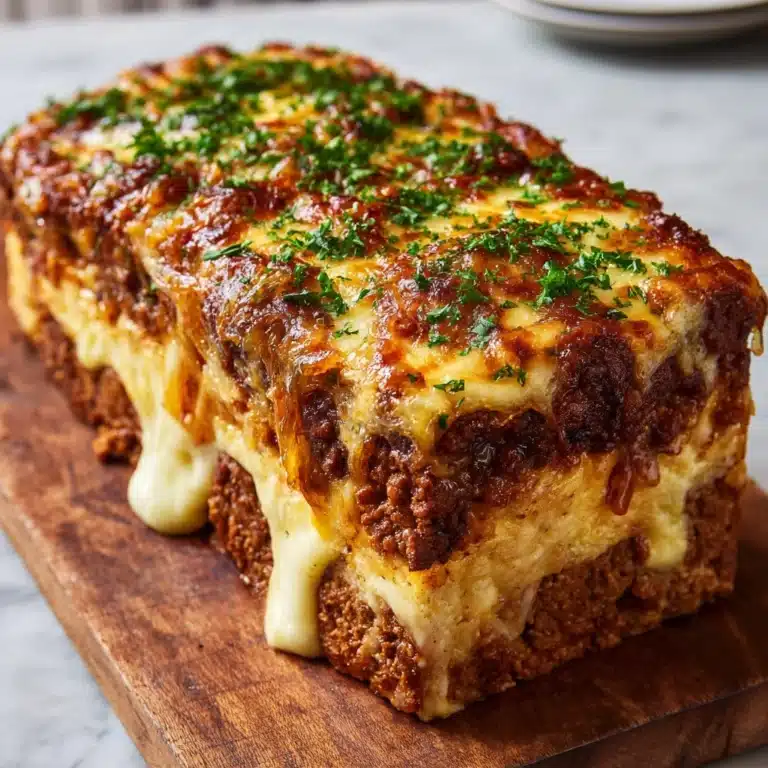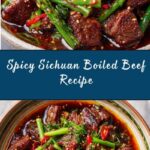Sichuan Boiled Beef Recipe
If you’re craving an electrifying combination of spice, savor, and tenderness, you’re in for an unforgettable experience with Sichuan Boiled Beef. This dish isn’t just about bold flavors—it’s a sensory adventure, starring melt-in-your-mouth beef slices bathed in a richly spiced broth, poured over blanched veggies, and finished with a fragrant, sizzling oil. Most famously known as “Shuizhu Niu Rou,” Sichuan Boiled Beef is a pillar of Sichuan cuisine, and whether you’re a seasoned spice lover or just dipping your toes in the chili-laden waters, this recipe will win you over from the very first bite.
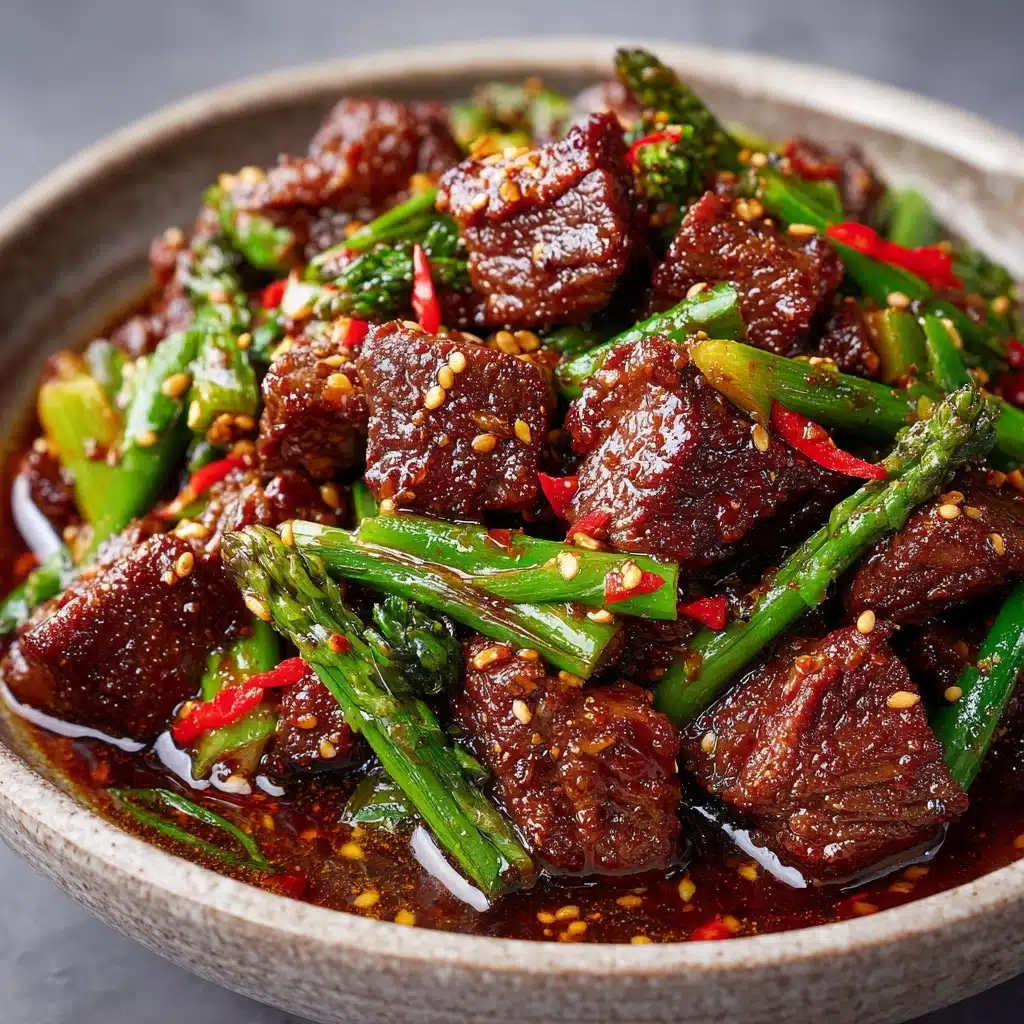
Ingredients You’ll Need
While the ingredient list for Sichuan Boiled Beef may look involved, each component serves a crucial role: from the fiery doubanjiang and numbing peppercorns to the crisp-tender veggies and luscious slices of beef. Grab these staples and get ready to transform them into a true showstopper!
- Beef sirloin or flank steak (1 lb, thinly sliced): Flank or sirloin delivers the perfect mix of tenderness and beefy flavor—be sure to slice against the grain for the best texture.
- Shaoxing wine (2 tablespoons): This Chinese rice wine adds depth and subtle sweetness to the marinade.
- Soy sauce (1 tablespoon): The umami backbone of the marinade brings savory complexity.
- Cornstarch (1 tablespoon): It creates a light coating on the beef, keeping each slice luxuriously tender.
- Salt (1/2 teaspoon): Essential for seasoning both the beef and the broth.
- Sichuan chili bean paste (Doubanjiang, 3 tablespoons): This spicy, salty, and intensely flavorful paste is the heart of any Sichuan Boiled Beef.
- Minced garlic (1 tablespoon): Adds aromatic depth and a kick of flavor that complements the chilies.
- Minced ginger (1 tablespoon): Bright and warming, ginger rounds out the spice profile.
- Sichuan peppercorns (2 teaspoons, lightly crushed): They give that signature numbing tingle and citrusy aroma.
- Dried red chilies (6–8, broken into pieces): These bring the dish’s throat-tingling heat—adjust to your spice preference.
- Napa cabbage or bean sprouts (4 cups, blanched): A fresh and crunchy base that soaks up the spicy broth beautifully.
- Vegetable oil (3 tablespoons): Used for both stir-frying and that iconic sizzling finish.
- Chicken broth, low-sodium (3 cups): This forms the comforting, flavorful bath for the beef.
- Scallions (2, sliced): Bright green scallion tops bring freshness and a pop of color.
- Chili oil (optional, for serving): For those who want another layer of spicy, aromatic richness.
How to Make Sichuan Boiled Beef
Step 1: Marinate the Beef
Start by placing the thinly sliced beef in a mixing bowl. Add the Shaoxing wine, soy sauce, cornstarch, and salt, then toss everything until each piece is evenly coated. Let the beef marinate and absorb all those foundational flavors for at least 20 minutes—it’s the secret to that juicy, silken texture that makes Sichuan Boiled Beef so irresistible.
Step 2: Build the Flavor Base
Heat 2 tablespoons of vegetable oil in a large wok or deep skillet over medium heat. Once shimmering, add the doubanjiang, minced garlic, ginger, Sichuan peppercorns, and dried red chilies. Stir-fry this aromatic mix for 1 to 2 minutes until it’s deeply fragrant—your kitchen should already start to smell intoxicating! This spicy foundation will infuse the broth with tons of complexity.
Step 3: Simmer the Broth
Carefully pour in the chicken broth and bring the whole mixture to a boil. Allow a minute or two for the flavors to meld. The bubbling, spicy broth is what transforms everything it touches into pure magic.
Step 4: Poach the Beef
Slip the marinated beef slices gently into the boiling broth, spreading them out to avoid clumping. Let them poach for 2 to 3 minutes—just until they lose their pink color and turn silky. Don’t overcook! This quick cooking keeps the beef mouthwateringly tender, the hallmark of great Sichuan Boiled Beef.
Step 5: Assemble the Layers
In your serving bowl, arrange the blanched Napa cabbage or bean sprouts as the first, crunchy layer. Pour the finished beef and its spicy broth right over the veggies, making sure every inch is smothered and soaking.
Step 6: The Sizzling Finishing Touch
Heat that last tablespoon of vegetable oil separately until it just starts to shimmer. Then, quickly pour it over the dish—it’s a dramatic and traditional touch that unlocks an explosion of aromatics, right before your eyes. Finish with sliced scallions and, if you like things fiery, a healthy drizzle of chili oil.
How to Serve Sichuan Boiled Beef
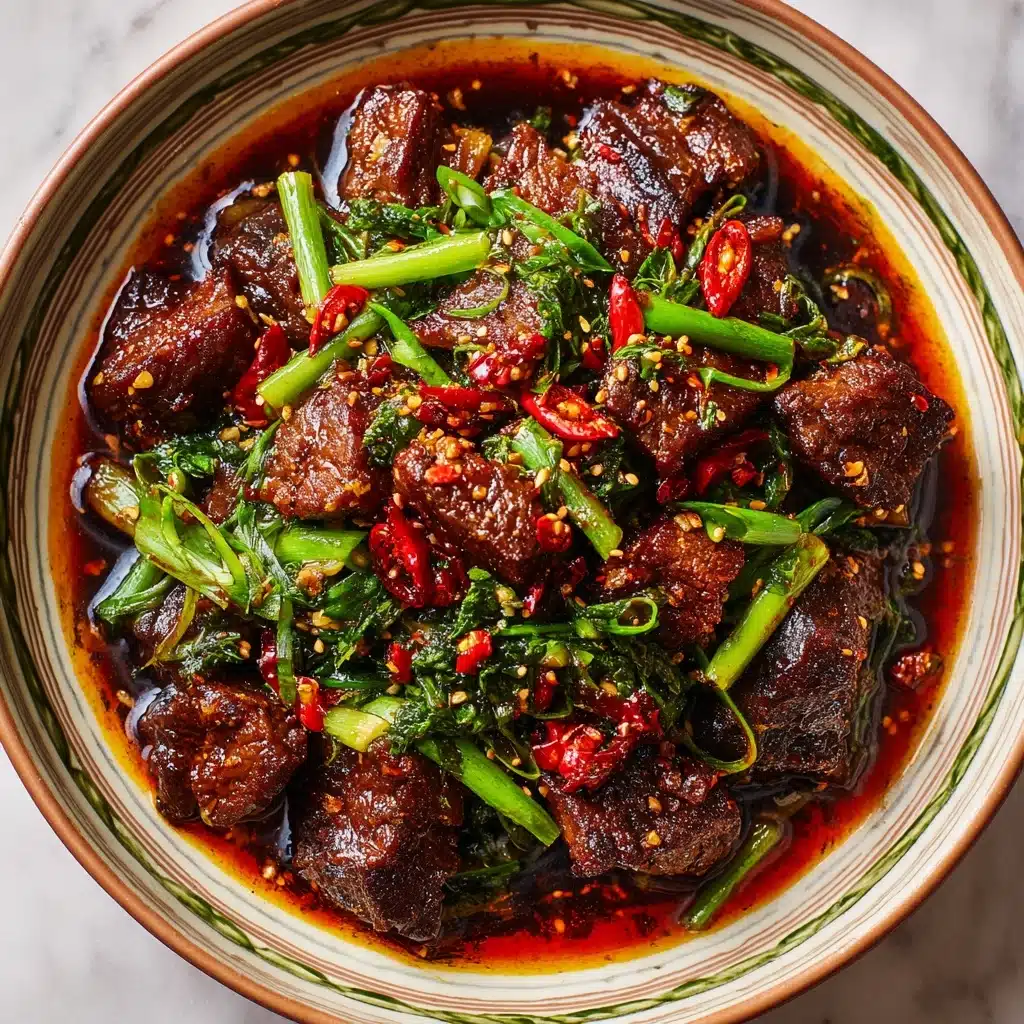
Garnishes
Sprinkle sliced scallions over the top for a burst of color and freshness that cuts through the richness. For extra heat and fragrance, don’t hesitate to add an extra dash of chili oil or a pinch of crushed Sichuan peppercorns. Each garnish elevates both the look and the mouthfeel of your Sichuan Boiled Beef.
Side Dishes
Soft, fluffy steamed rice is an absolute must—it soaks up all that spicy broth and helps balance out the bold flavors. Consider pairing your Sichuan Boiled Beef with simple stir-fried greens, chilled cucumber salad, or garlicky Chinese broccoli for a cooling counterpoint to all the heat.
Creative Ways to Present
For a dramatic tableside effect, bring the sizzling hot oil to the table and pour it over the assembled bowl just before serving, letting your guests enjoy the heady aroma. Or, serve individual portions in small earthenware bowls to turn the meal into a special, family-style event that everyone can personalize with their chosen garnishes.
Make Ahead and Storage
Storing Leftovers
Cool any leftover Sichuan Boiled Beef to room temperature before transferring it to an airtight container. It will keep well in the refrigerator for up to three days. The flavors actually deepen over time, making your lunch or next-day dinner even more satisfying.
Freezing
If you want to save your Sichuan Boiled Beef longer, freezing is totally doable. Place cooled leftovers in a freezer-safe container or resealable bag, removing as much air as possible. It will keep its punchy flavors for up to two months; just be aware the vegetables may lose some of their crispness.
Reheating
To bring your stored Sichuan Boiled Beef back to life, gently reheat it in a saucepan over medium-low heat, stirring occasionally until just warmed through. Add a splash of chicken broth if the sauce is too thick. Microwave reheating works as well—just use medium power to prevent the beef from overcooking.
FAQs
What if I can’t find Sichuan chili bean paste (doubanjiang)?
Doubanjiang is the flavor backbone of this recipe, but if it’s hard to find, you can substitute with a mix of miso paste and a hot chili sauce like sambal oelek, though the flavor won’t be quite as signature. Make it a point to source the real deal for the most authentic Sichuan Boiled Beef experience when possible.
Can I use a different protein instead of beef?
Yes! You can use thinly sliced pork, chicken, or even tofu for a lighter but still fiery twist. Adjust your cooking time accordingly for different proteins; the key is to poach gently so everything stays tender, just like the original Sichuan Boiled Beef.
How spicy is this recipe—and how can I adjust it?
Sichuan Boiled Beef is meant to deliver some heat, but you’re in control. Reduce the number of dried chilies or skip the chili oil for a tamer version, or amp it up with extra chilies and a big spoonful of chili crisp for the brave!
What’s the secret to keeping the beef tender?
Start with thinly sliced beef (partially freezing it helps make slicing easier and thinner). Marinate thoroughly and, above all, avoid overcooking when poaching. These steps are essential for that silky, almost melt-in-your-mouth bite that makes Sichuan Boiled Beef unforgettable.
Can I prepare anything ahead of time?
Absolutely! You can slice and marinate the beef, chop all your aromatics, and blanch the veggies up to a day ahead. When it’s time to cook, you’ll have all your elements ready for a fuss-free, fresh Sichuan Boiled Beef.
Final Thoughts
There’s something thrilling about sharing a big, aromatic bowl of Sichuan Boiled Beef with family or friends—the warmth, the sizzle, the joy of punchy flavors dancing together in every bite. If you’re ready to spice up your mealtime routine with a classic that never gets old, this recipe is your ticket to true Sichuan comfort. Give it a try, and watch it become a new favorite at your table!
Print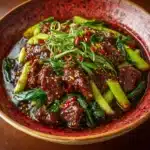
Sichuan Boiled Beef Recipe
- Total Time: 35 minutes
- Yield: 4 servings
- Diet: Non-Vegetarian
Description
Sichuan Boiled Beef is a classic Chinese dish packed with bold and spicy flavors. Tender slices of beef are poached in a fragrant and fiery broth, then served over a bed of crisp vegetables. This recipe captures the essence of Sichuan cuisine in a comforting and satisfying bowl.
Ingredients
Marinated Beef:
1 lb beef sirloin or flank steak (thinly sliced against the grain), 2 tablespoons Shaoxing wine, 1 tablespoon soy sauce, 1 tablespoon cornstarch, 1/2 teaspoon salt.
Spicy Broth:
3 tablespoons Sichuan chili bean paste (Doubanjiang), 1 tablespoon minced garlic, 1 tablespoon minced ginger, 2 teaspoons Sichuan peppercorns (lightly crushed), 6–8 dried red chilies (broken into pieces), 3 tablespoons vegetable oil.
Additional:
4 cups Napa cabbage or bean sprouts (blanched), 3 cups low-sodium chicken broth, 2 scallions (sliced), optional chili oil for serving.
Instructions
- Marinate the Beef: Combine beef with Shaoxing wine, soy sauce, cornstarch, and salt. Set aside.
- Prepare the Spicy Broth: Heat oil in a wok, add chili bean paste, garlic, ginger, peppercorns, and chilies. Stir-fry, then add chicken broth and bring to a boil.
- Poach the Beef: Add marinated beef to the broth, cook for 2–3 minutes.
- Assemble: Place blanched cabbage or bean sprouts in a serving bowl. Pour beef and broth over the vegetables.
- Finish: Drizzle hot oil over the top, garnish with scallions and chili oil.
Notes
- For extra spice, add more dried chilies or chili crisp.
- Thinly slicing beef ensures tenderness; partially freeze the meat for easier slicing.
- Prep Time: 20 minutes
- Cook Time: 15 minutes
- Category: Main Course
- Method: Stovetop
- Cuisine: Chinese
Nutrition
- Serving Size: 1 bowl
- Calories: 340
- Sugar: 3g
- Sodium: 800mg
- Fat: 20g
- Saturated Fat: 4g
- Unsaturated Fat: 15g
- Trans Fat: 0g
- Carbohydrates: 8g
- Fiber: 2g
- Protein: 30g
- Cholesterol: 75mg
